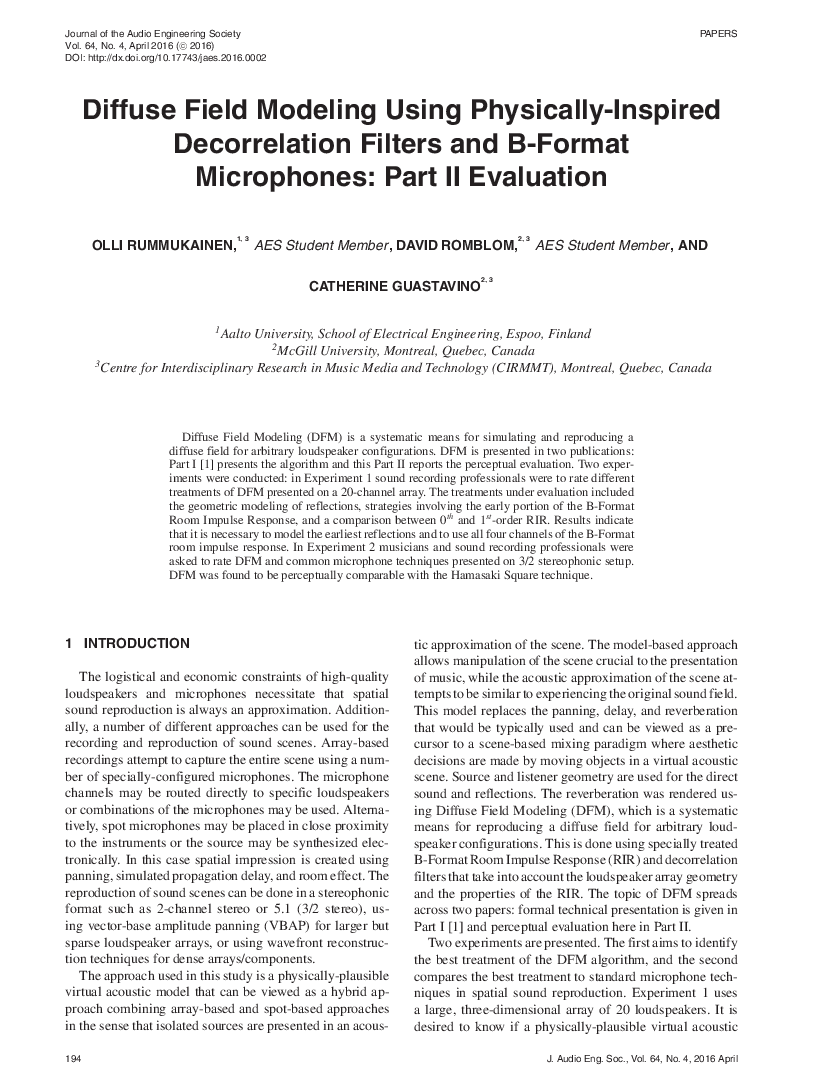Home / Publications / E-library page
You are currently logged in as an
Institutional Subscriber.
If you would like to logout,
please click on the button below.
Home / Publications / E-library page
Only AES members and Institutional Journal Subscribers can download
The Diffuse Field Model (DFM) described in Part 1 is perceptually evaluated in this article. Two experiments were conducted. In first experiment, sound recording professionals rated different treatments of DFM presented on a 20-channel array. This evaluation included the geometric modeling of reflections, strategies involving the early portion of the B-Format Room Impulse Response (RIR), and a comparison between 0th- and 1st-order RIR. Results indicate that it is necessary to model the earliest reflections and to use all four channels of the B-Format room impulse response. In the second experiment, musicians and sound recording professionals were asked to rate DFM and common microphone techniques presented on 3/2 stereophonic setup. DFM was found to be perceptually comparable to the Hamasaki Square technique. DFM approach used in this study is part of a physically-plausible virtual acoustic model for sources that were captured with close microphone placement. This model replaces the panning, delay, and reverberation that would typically be used. DFM is a perceptually viable method to create room impression that allows free placement of anechoic point sources in arbitrary multichannel loudspeaker setups.
Author (s): Rummukainen, Olli; Romblom, David; Guastavino, Catherine
Affiliation:
Aalto University, School of Electrical Engineering, Espoo, Finland; McGill University, Montreal, Quebec, Canada; Centre for Interdisciplinary Research in Music Media and Technology (CIRMMT), Montreal, Quebec, Canada
(See document for exact affiliation information.)
Publication Date:
2016-04-06
Import into BibTeX
Permalink: https://aes2.org/publications/elibrary-page/?id=18128
(462KB)
Click to purchase paper as a non-member or login as an AES member. If your company or school subscribes to the E-Library then switch to the institutional version. If you are not an AES member Join the AES. If you need to check your member status, login to the Member Portal.

Rummukainen, Olli; Romblom, David; Guastavino, Catherine; 2016; Diffuse Field Modeling Using Physically-Inspired Decorrelation Filters and B-Format Microphones: Part II Evaluation [PDF]; Aalto University, School of Electrical Engineering, Espoo, Finland; McGill University, Montreal, Quebec, Canada; Centre for Interdisciplinary Research in Music Media and Technology (CIRMMT), Montreal, Quebec, Canada; Paper ; Available from: https://aes2.org/publications/elibrary-page/?id=18128
Rummukainen, Olli; Romblom, David; Guastavino, Catherine; Diffuse Field Modeling Using Physically-Inspired Decorrelation Filters and B-Format Microphones: Part II Evaluation [PDF]; Aalto University, School of Electrical Engineering, Espoo, Finland; McGill University, Montreal, Quebec, Canada; Centre for Interdisciplinary Research in Music Media and Technology (CIRMMT), Montreal, Quebec, Canada; Paper ; 2016 Available: https://aes2.org/publications/elibrary-page/?id=18128
@article{rummukainen2016diffuse,
author={rummukainen olli and romblom david and guastavino catherine},
journal={journal of the audio engineering society},
title={diffuse field modeling using physically-inspired decorrelation filters and b-format microphones: part ii evaluation},
year={2016},
volume={64},
issue={4},
pages={194-207},
month={april},}
TY – paper
TI – Diffuse Field Modeling Using Physically-Inspired Decorrelation Filters and B-Format Microphones: Part II Evaluation
SP – 194 EP – 207
AU – Rummukainen, Olli
AU – Romblom, David
AU – Guastavino, Catherine
PY – 2016
JO – Journal of the Audio Engineering Society
VO – 64
IS – 4
Y1 – April 2016